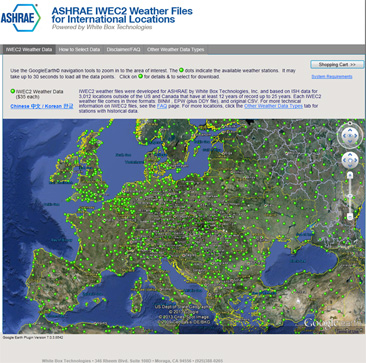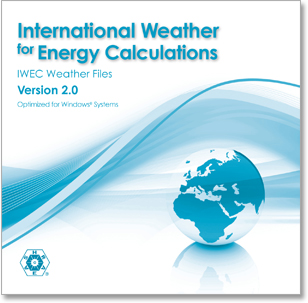ASHRAE climatic design conditions station finder. Just right click: on site on the map and get nearest weather stations! Weather Data for Building Design Standards. PURPOSE: This standard provides recognized weather data for use in building-design and related equipment standards. SCOPE: – This standard covers weather data used in ASHRAE standards, including dry-bulb, dew-point and wet-bulb temperatures, enthalpy, humidity ratio, wind conditions, solar. Quick tutorial on how to download climate station data from the NOAA website using the Mapping Tool. Remington 1100 serial number l prefix. Pro tip: try dates in 1981 or 1971 if you're having trou. B uilding energy simulations require weather data as an essential input. ASHRAE, in collaboration with White Box Technologies (WBT), now provides web access to ASHRAE's IWEC2 'typical year' weather files for 3,012 international locations outside of the US and Canada. IWEC2 weather files can be purchased individually, as sets by country. Discounts and special pricing for additional items will be applied once you add the item to your cart.
What is CCWorldWeatherGen?
The climate change world weather file generator (CCWorldWeatherGen) allows you to generate climate change weather files for world-wide locations ready for use in building performance simulation programs. It uses Intergovernmental Panel on Climate Change (IPCC) Third Assessment Report model summary data of the HadCM3 A2 experiment ensemble which is available from the IPCC Data Distribution Centre (IPCC DDC) (1,2). The tool is Microsoft® Excel based and transforms ‘present-day’ EPW weather files into climate change EPW or TMY2 weather files which are compatible with the majority of building performance simulation programs.
The underlying weather file generation routines of this tool are based on the so-called ‘morphing’ methodology for climate change transformation of weather data, which was developed by Belcher, Hacker and Powell (3). It builds on previous work by the Sustainable Energy Research Group on climate change transformation of UK weather data (4) (see also the web pages on the CCWeatherGen tool).
The CCWorldWeatherGen tool allows you to generate climate change weather files with a few mouse clicks. You can produce ‘morphed’ EPW and TMY2 files as well as present-day TMY2 files from the original EPW format files. The tool is made available free of charge. However, it is solely distributed WITHOUT the required baseline weather files and/or climate change scenario data! (Please view sections 2.1 and 2.2 of the CCWorldWeatherGen Manual for information on where to obtain the required baseline data.)
Important – please note:
The CCWorldWeatherGen tool uses coarse General Circulation Model (GCM) data. Therefore, CCWorldWeatherGen users are requested to familiarise themselves with the IPCC assessment reports to appreciate limitations and handle uncertainties of the climate change weather data generated with this tool. For sites in the UK it is recommended to use the CCWeatherGen tool instead, as this uses more detailed Regional Climate Model (RCM) data.
Publications
Details on the underlying methodology used in CCWorldWeatherGen can be found in the following publication:
Jentsch M.F., James P.A.B., Bourikas L. and Bahaj A.S. (2013) Transforming existing weather data for worldwide locations to enable energy and building performance simulation under future climates, Renewable Energy, Volume 55, pp 514-524. view paper
Download CCWorldWeatherGen V 1.8 and associated manuals
Please note that the tool does not currently work with the 2013 version of Microsoft® Excel. We are working on resolving this issue. In the meanwhile please use the 2003, 2007 or 2010 version of Microsoft® Excel for weather data conversion
CCWorldWeatherGen is provided as a self-extracting file within a zip file. Please click the link below, unzip the file, run the executable and follow the instructions on the screen.


Ashrae Weather Data Viewer Free Download Adobe
All instructions required for CCWorldWeatherGen are given in the user manual. It is highly recommended to read the manual before using the tool.
The calculation routines underlying the CCWeatherGen and CCWorldWeatherGen tools are detailed in a technical reference manual:
Copyright and Licensing Notes
The original weather files used for generating climate change adapted weather data may be copyrighted material. Therefore, generated weather files can only be used by persons or entities who possess the corresponding licensed weather files. The user of this tool takes the sole responsibility of complying with the terms and conditions of the original weather data as well as the climate change scenario data used within this tool. Files generated with this tool may not be distributed to a third party.
Ashrae Weather Data Table
Disclaimer of Warranties
The entire risk as to the quality, accuracy and performance of the climate change weather data calculated with this tool is with you. In no event will the authors of the weather file generation tool be liable to you for any damages, including without limitation any lost profits, lost savings, or other incidental or consequential damages arising out of the use or inability to use this tool and/or its generated data.
Ashrae Weather Data Viewer Free Download For Mac
Acknowledgements

The authors gratefully acknowledge the HadCM3 general circulation model (GCM) data by the UK Met Office Hadley Centre (1) which is required for this tool and can be downloaded from the IPCC Data Distribution Centre website (2). The morphing methodology for generating climate change weather data bases on the methods developed by Belcher, Hacker and Powell (3). Special thanks go to Linda Lawrie and Drury Crawley for providing guidance on the appropriate ground temperature equations for generating EPW files. Gta vice city full pc game blogspot com free.
Furthermore the work of the following people / institutions that was key to compiling this weather file generator tool is also gratefully acknowledged: the ASHRAE psychrometric formulae (5), the TMY2 weather file manual by Marion and Urban (6), the EPW weather data description by Crawley, Hand and Lawrie (7), the all sky model for calculating downwelling longwave radiation by Crawford and Duchon (8), the models for calculating illuminance and sky luminance parameters from radiation data by Perez, Ineichen, Seals, Michalsky and Stewart (9), the ground temperature equation by Kusuda and Achenbach (10), the optical air mass tables provided by Kasten and Young which were used for calculating illuminance and sky luminance parameters (11), the Boland-Ridley-Lauret (12) model which was used for calculating diffuse horizontal radiation and CIBSE Guide J which was used for calculating direct normal solar radiation (13).
The self extracting download file was generated using FreeExtractor v1.44

This work has been undertaken within the project ‘Climate change implications for buildings and their technical services in tropical and moderate climates’ under the PMI2 Connect research programme funded by the British Council. This project is a joint project between the Sustainable Energy Research Group at the University of Southampton and the Department of Mechanical Engineering at the University of Malaya in Kuala Lumpur. Special thanks go to go to Leonidas Bourikas for investigating models for deriving diffuse horizontal radiation from global horizontal radiation and Dr Yau Yat Huang, Choo Khean Chang and Muhammad Hafiz Azizan for testing the climate change data under tropical climates. This tool represents a further development of previous work conducted under the UK Government Engineering and Physical Sciences Research Council (EPSRC) funded research programme ‘Innovation in Design, Construction & Operation of Buildings for People’ (IDCOP).

Ashrae Weather Station Data
References
Ashrae Weather Data Viewer Free Download Version
- Met Office Hadley Centre, Exeter, UK, http://www.metoffice.gov.uk
- IPCC Data Distribution Centre, HadCM3 climate scenario data download page, http://www.ipcc-data.org/sres/hadcm3_download.html
- Belcher SE, Hacker JN, Powell DS. Constructing design weather data for future climates. Building Services Engineering Research and Technology 2005; 26 (1): 49-61.
- Jentsch MF, Bahaj AS, James PAB. Climate change future proofing of buildings – Generation and assessment of building simulation weather files. Energy and Buildings 2008; 40 (12): 2148-2168. view paper
- ASHRAE. Chapter 6 – Psychrometrics. ASHRAE Handbook – Fundamentals. Atlanta: American Society of Heating Refrigerating and Air-Conditioning Engineers, 2005.
- Marion W, Urban K. User’s Manual for TMY2s – Typical Meteorological Years. Golden, Colorado, USA: National Renewable Energy Laboratory 1995.
- Crawley DB, Hand JW, Lawrie LK. Improving the weather information available to simulation programs. Building Simulation ‘99 Conference. Kyoto, Japan; 1999.
- Crawford TM, Duchon CE. An improved parameterization for estimating effective atmospheric emissivity for use in calculating daytime downwelling longwave radiation. Journal of Applied Meteorology 1999; 38 (4): 474-480.
- Perez R, Ineichen P, Seals R, Michalsky J, Stewart R. Modelling Daylight Availability and Irradiance Components from Direct and Global Irradiance. Solar Energy 1990; 44 (5): 271-289.
- Kusuda T, Achenbach PR. Earth temperature and thermal diffusivity at selected stations in the United States. ASHRAE Transactions 1965; 71 (1): 61-74.
- Kasten F, Young AT. Revised optical air mass tables and approximation formula. Applied Optics 1989; 28 (22): 4735-4738.
- Ridley B, Boland J, Lauret P. Modelling of diffuse solar fraction with multiple predictors. Renewable Energy 2010; 35: 478-483.
- CIBSE. CIBSE Guide J – Weather, solar and illuminance data. London: The Chartered Institution of Building Services Engineers, 2002.
